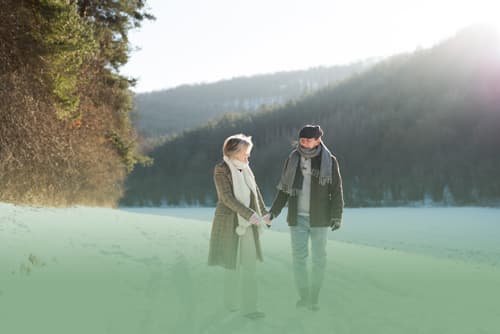Fall Prevention Is Especially Crucial in the Winter Months.
Slips and falls become more of a concern as you age, and the winter months are especially dangerous. One wrong step and you could land in the emergency room with a broken bone.
Kaitlin Watson, an occupational therapist at Summit Therapy and Health Services, provides some tips for staying safe. “If you’ve ever heard the saying ‘walk like a penguin’ outside in the snow, that’s a really good way to go,” she notes. “Go slow. Turn your feet so your toes point outwards and take small steps. Try to avoid carrying anything in your arms when you're walking on slippery ground; that way your arms can do their job of being a good counter balance. Turn slowly, and really avoid making any quick movements whatsoever.”
If you are an avid walker and enjoy exercising outside year-round, Watson advises avoiding majorly steep hills or driveways with severe slants. Supportive shoes with good traction will help, or you may even consider adding extra traction to your shoes (like Yaktrax or something similar) to help with grip. Trekking poles or a walking stick are also good options for maintaining balance. If you do fall, Watson says the first step is to take a minute to assess yourself and make sure you're not injured. “If you can get up and keep going, get inside,” she cautions. “If you have a hard time getting up from the ground, a good technique is to get onto your hands and knees and crawl to a stable surface where you can slowly pull yourself up with your arms and sit down for a while before heading inside.”
For Seniors, Risk of Falling Exists Year-Round
While winter falls are a risk for any age population, from teenagers to the elderly, seniors experience an increased risk year-round. Based on population demographics, individuals aged 65 and older have a 30 percent chance of falling every year. The American Geriatric Society, the Centers for Disease Control, and Medicare all recommend those 65 years and older get screened for falls every time they present to a healthcare practitioner.
“We want to try to prevent falls and identify any risk factors early on, so we can make it less likely they’ll fall, based on a number of factors,” explains Watson.
Five main risk factors are responsible for the majority of slips and falls:
-
History of falls, particularly within the last six months.
-
Psychoactive medications, including opioids, anti-depressives, anti-psychotics, sedatives, and sleeping agents.
-
Needing assistance with self-care tasks or activities, often due to pain or physical impairment.
-
Self-reported fear of falling which limits you from participating in activities you enjoy or that are needed to get through daily life.
-
Gait or imbalance impairment.
Watson cites a few additional risk factors, including impaired vision, low muscle strength or flexibility, urinary incontinence or urinary urgency, pain, depression, impaired cognition, dizziness, frequent shortness of breath, tingling or numbness in your feet, and alcohol and drug use.
How to Prevent Falls
In order to prevent falls from occurring, Watson encourages individuals to be proactive—both on their own and in the doctor’s office. For example, ask your primary care provider if your medications might increase the likelihood of a fall or request a multi-factorial fall evaluation from a physical therapist.
Without having to go to your doctor, there are also a number of things individuals can do on their own. These include regular vision and hearing exams, wearing proper shoes all year round (stay away from flip-flops), staying active, and assessing potential dangers within the home.
“I always advise people to reduce any home trip hazards like throw rugs. Keep your passageways clear of anything you could possibly catch a toe or a walker on,” suggests Watson. “Also, use good lighting. Keep smoke detectors up to date. The CDC actually has a great brochure with tips on home safety.”
Community-Based Care and Fall Risk Assessments
Summit Therapy offers a free fall risk screening on the third Tuesday of every month. “Folks are welcome to come in and just start asking those questions and see where they’re at,” shares Watson. “It doesn’t take too long, and then we can discuss what would be the best direction in terms of fall prevention.”
The center also provides outpatient physical and occupational therapists who work on evaluation and treatment, vestibular therapists who focus on the factors associated with dizziness and vertigo, and pelvic health therapists, both men and women, who help address the needs of those afflicted by urinary urgency and incontinence.
“If anyone is wanting to stay active under the guidance of a physical therapist, the SAIL class or the Tai Chi class are great options,” recommends Watson. “Both classes are proven to help reduce falls. Then, if you have any questions at all, you can always contact Summit Therapy or come by on that third Tuesday of every month to get screened.”
More Resources on falls from the CDC:

